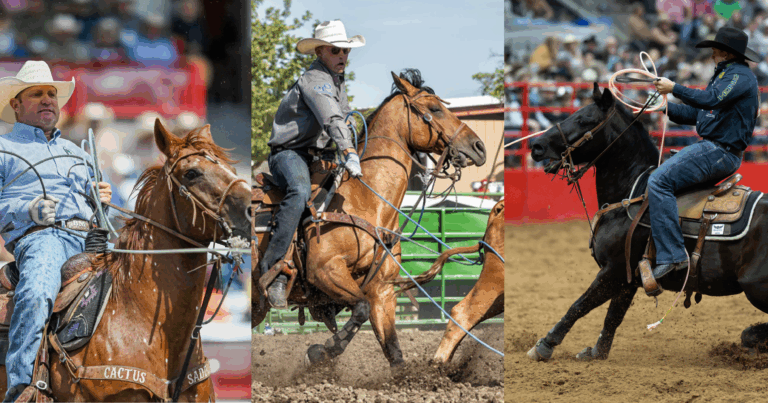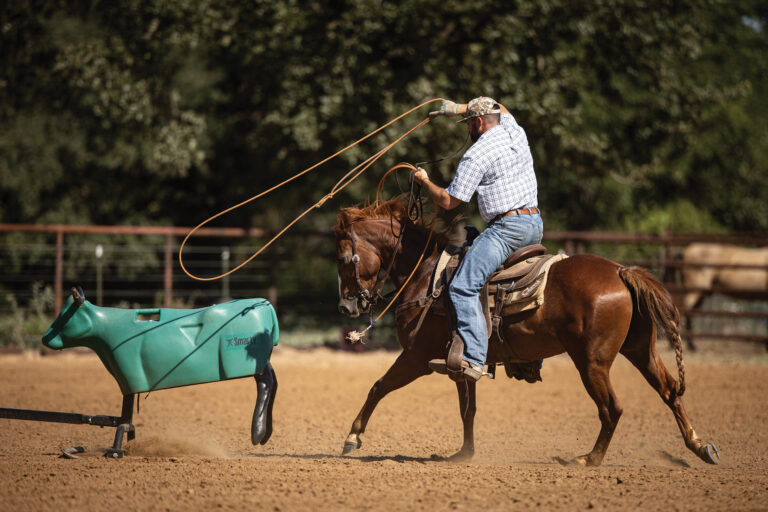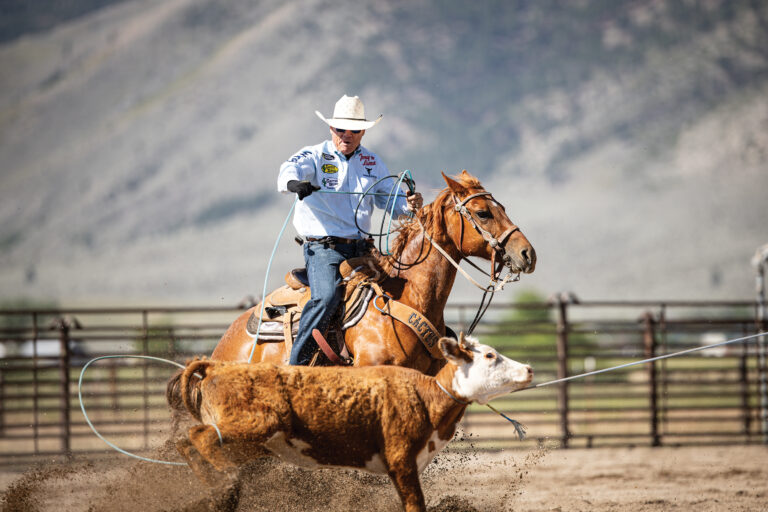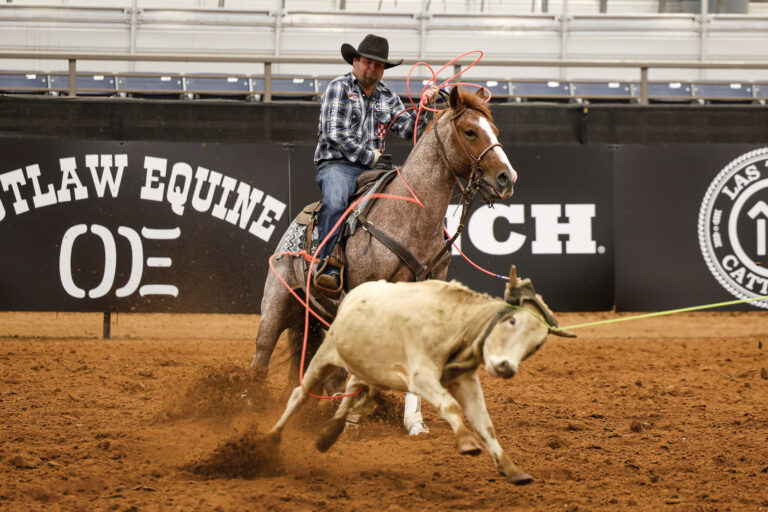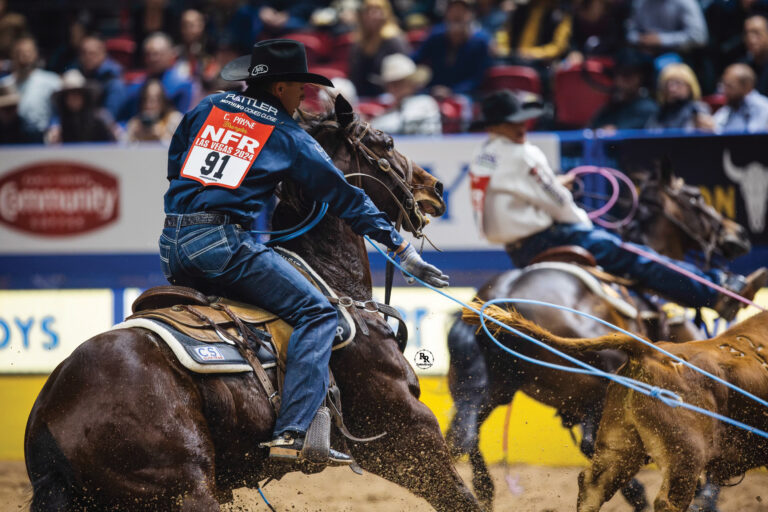Ever ridden a heel horse that does virtually everything for you? That can literally make you catch two feet?
One of the best in the world at it was Dunny Bar Five Koys, owned by two different world champs. Dunny traded Horse of the Year awards back and forth with Iceman throughout the early 1990s. He never took your throw away because he kept moving his front feet in his stop.
Former world champion heeler Steve Northcott puts it in simple terms: “If a horse is dropping its rear end but also giving you two steps, it’s a lot easier to place your loop down there.”
The veteran heeler, who owns Northcott Trucking with his wife, Celeste, recently moved to Huckabee, Texas, and plans to begin offering private roping lessons this fall. He has a case-in-point about Dunny. Northcott said that a few decades ago, Roy Cooper could easily have won the Timed Event Championship of the World a handful of times – except for his annual heeling struggles. One year, Cooper borrowed Dunny. Riding that horse in Guthrie, Cooper broke the fast-time record in the heeling.
Of course, Dunny also helped Allen Bach come tight on a gold buckle. Bach calls the dun horse the best he’s ever ridden—and that’s from a roster that includes million-dollar sticks Jackyl and Switchblade.
Dunny is not the only equine G.O.A.T. that got that way because of his speed and stopping style. Fast-throw artist Dakota Kirchenschlager, 28, has studied the mechanics of the stop while transitioning from three-time NFR heeler to full-time rope-horse trainer. His two favorite stoppers over the years? Brady Minor’s Rey and Randon Adams’ Diesel.
“They’re both big horses but when they stopped, they always kept their shoulders picked up,” said Kirchenschlager, now training out of Whitesboro, Texas. “I always liked that about those two horses. Some smaller horses, you’ll see them drop their front end a little when they stop. Another one who keeps his front end up throughout the run is that horse Cory Petska won the world on, with no tie-down.”
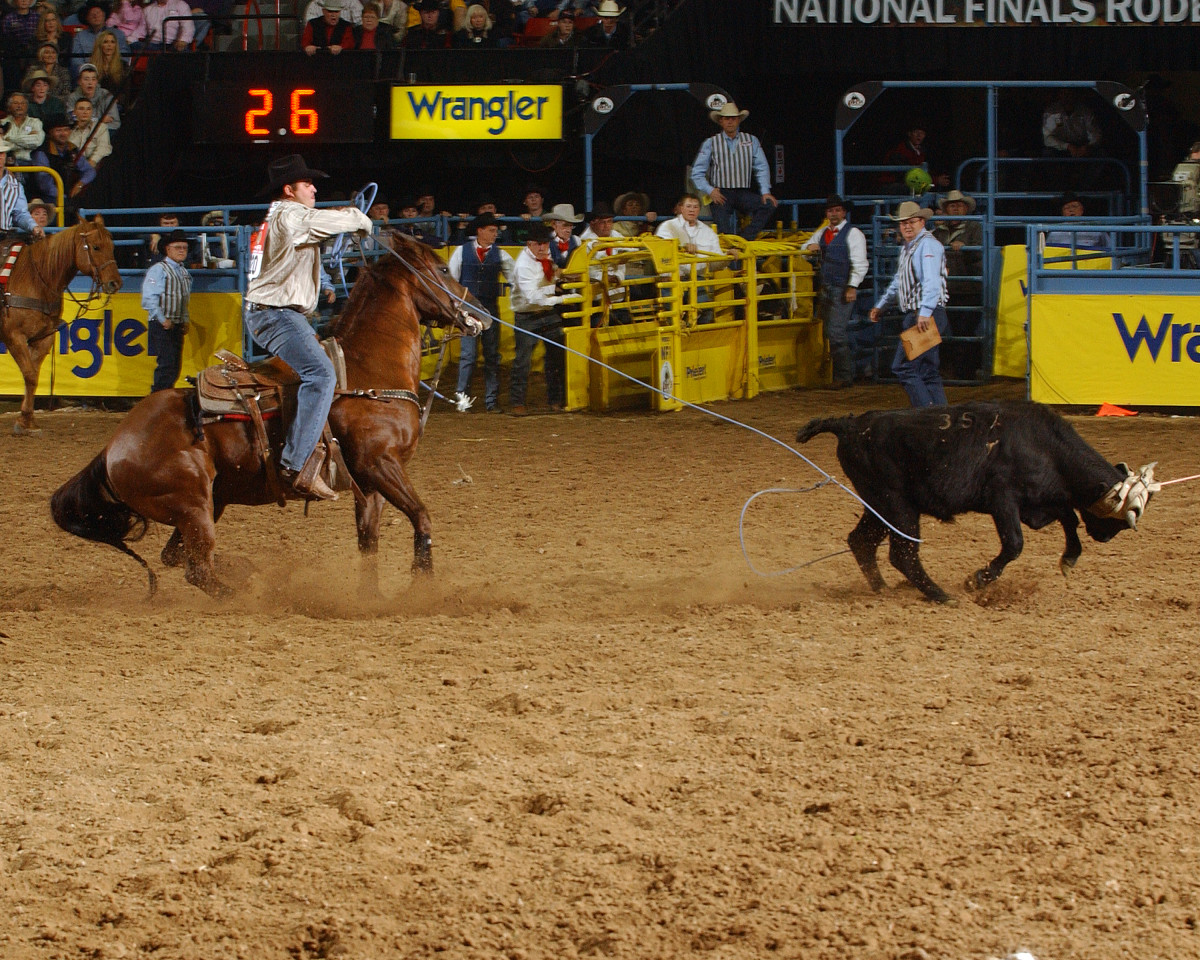
Heel Horse Form: Straight and Solid
It takes elevated, free-moving shoulders to pedal the front end as the rear end screws into the ground. This stopping style is basically what garnered Dunny, Rey and Diesel eight collective PRCA/AQHA Horse of the Year awards. Obviously, there are also other priorities, too. For two-time champ of the world and recent Rodeo California winner Walt Woodard, it’s crucial that a horse stops real square.
“If a heel horse quarters just a little bit, it moves that right hip over just a tick and makes it easy to miss the horn with your dally,” said Woodard. “Not only that, but if horses take the jerk sideways, they get to dreading it.”
While Woodard prefers his horses don’t quarter even an inch, two-time NFR heeler and 14-time AQHA world champ Jay Wadhams doesn’t mind a horse that quarters just a touch. He lets a horse keep its head out of the way, though he doesn’t let one take the jerk sideways.
The biggest problem Wadhams sees for heelers is that their horses leak forward in the stop. Obviously, that’s not the way to get a good, fast flag. That’s also why the pros don’t prefer their heel horse slide very far, if at all. At the judged horse shows, Wadhams rides horses with sliders on their hind feet because a slide looks pretty. But again, a horse that’s moving forward is not getting stopped, and time is money at jackpots.
“Team roping has gotten so competitive that if a horse slides too far and your rope runs just a little bit, it adds another 1/10 of a second,” Woodard said. “Everything has to be so precise anymore.”
Regardless of slide or not, Woodard agrees that a heel horse must learn how to break loose in the front end. Many horses have so much natural rate that they know by the speed of your rope when you’re about to deliver, so they should read that and begin to drop their rear end into the ground—but also “break loose” with their front end, he said.
So what does that mean, and how can you encourage it?
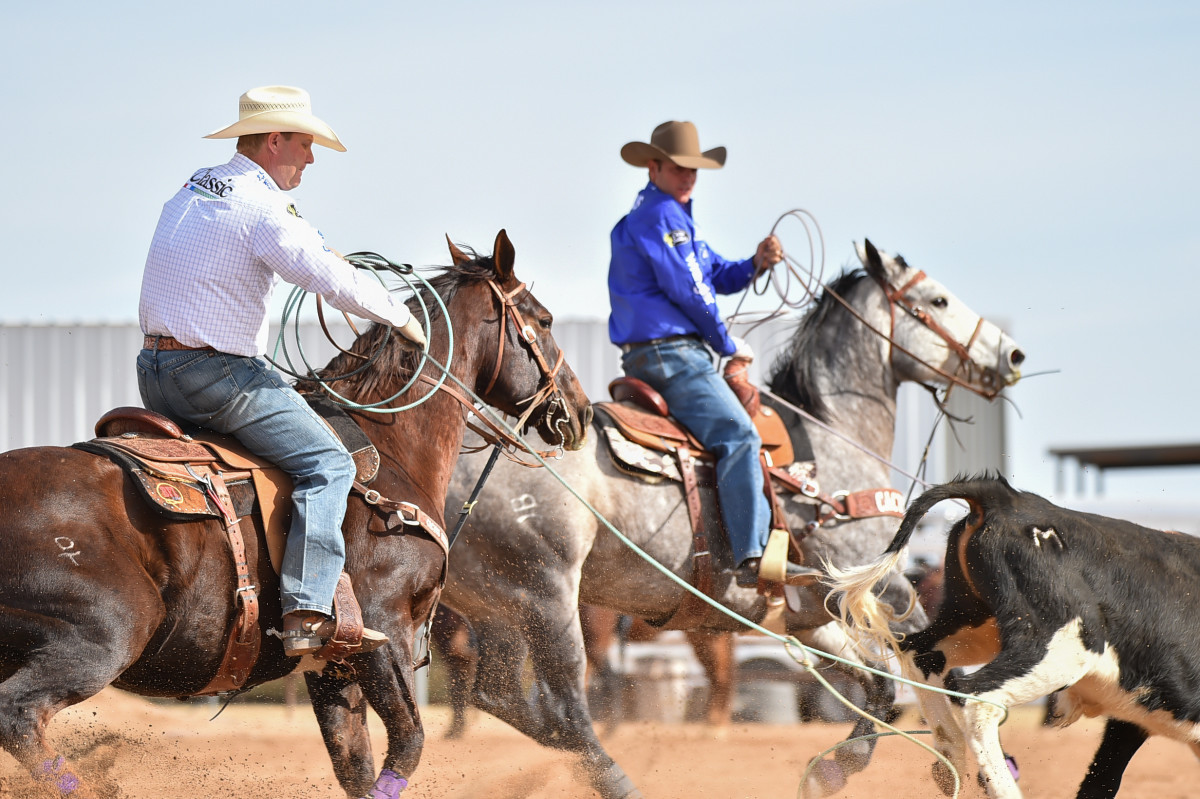
Heel Horse Evolution: From Punching to Pedaling
A self-professed student of the stop is full-time rope-horse trainer Steven Hardcastle of Hico, Texas. He spent time working for four-time world champ Allen Bach and a year working for Hall-of-Fame horseman Bobby Lewis while living amongst reining trainers.
What Kirchenschlager describes as “dropping the front end” is what Hardcastle calls “punching.” A horse punches the ground with its front end because its shoulders are locking up, he said.
“When you really see one swallow the earth and pedal in the front end, it looks so rank,” added Hardcastle, 41. “That’s a top-notch athlete. A sliding horse might mean you come tight slower, but it’s also easier on your body, and it might be easier on a horse’s body. Those sliding horses leave parallel 11s and stop with their hocks. But those big, flashy stoppers that can cut your hand off, they leave tracks that start narrow and widen at the end. Those horses are stopping with everything they have—they’re stopping with their stifles.”
Since time is money, people at Walt Woodard’s clinics are constantly asking him how they can get their horse to stop better.
“The answer is, your horse needs to be broke better,” Woodard said. “That’s how he stops better. It happens in the beginning. We want one to have that foundation before we ever start to rope on a horse.”

Hardcastle agrees. He has transformed plenty of horses over the years from punchers into pedalers, simply by getting them more broke and teaching them to soften those front ends.
“If your horse can’t back up in a straight line, he probably doesn’t stop very well,” he said. “A horse has to be able to travel in a straight line and also back up straight. That means the horse needs to be broke in the face and to your feet.”
Once your horse is broke to each side and backing up straight, Hardcastle also recommends you make sure you’re sitting in the middle.
“NFR average champion heeler Michael Jones said once that when you’re riding a heel horse, imagine you’re riding a tube of toothpaste,” said Hardcastle. “If your weight is too far forward, the paste will squeeze out the back. If you’re too far back, it goes out the front. Sit right in the middle.
“Bobby [Lewis] is the best at sitting in the middle of one, which allows a horse to just suck through himself in a stop,” he added. “I was good at it, just riding. But when I roped, I tended to chase the steer with my chest and lean over the front end of my horse. So I spent an entire year working on sitting in the middle and using my legs to drive my horse to the cow, and that made my horses stop even bigger.”
Heel Horse Training Tip: Set Up Your Heel Shot
Hardcastle said you can teach a horse to get in the ground without dropping its front end by working on stops away from steers. For instance, if it feels like your horse’s front end is traveling too much and his rear end isn’t dropping enough, back him up just after each stop.
There are also a couple of drills Hardcastle uses to loosen those locked shoulders and get rid of the punch. For instance, lope your horse down the arena and stop him. If he punches, immediately squeeze him forward and move his front end out and around, say, to the left.
“Make sure he crosses his outside foot over his left foot,” said Hardcastle. “That’s a big deal. You want the inside foot to follow the horse’s nose, and the outside foot to cross over the inside. Then lope off again. If he punches again, squeeze him forward and turn him with the outside foot crossing over again. You want a horse to not be sticky with those front feet—make him reach with them. Eventually, he’ll learn to pedal them forward. Reward after you get just one step. Eventually, you’ll get more.”
Hardcastle also uses a technique called “fencing.” He drives a horse two-handed toward a fence and sits down and says whoa, but then lets the fence stop the horse. Another drill is to trot down parallel with the fence and then pull your horse’s nose toward the fence until he’s perpendicular to it. Feed him the reins as he drags his rear end. Then use your outside leg to push his front end around and make him go somewhere.
If these exercises alone aren’t helping eliminate the punch, make sure you’re working your horse in ground conducive to a pedaling stop (sandy with a base), and make sure your horse’s teeth have been maintained. You can also try putting sliders on temporarily.
We all know there’s a lot to heeling. If adding a great stop to the equation seems overwhelming, try recalling the easy-to-remember mantra Hardcastle calls “bottom-bottom.”
“I want to put my bottom in the saddle and my bottom strand on the ground and feel my horse hit the bottom of the stop—but be free in the front end.”
A horse’s own genes and training go a long way toward an award-winning stop but, at the end of the day, the stop is really an art. The freak heel horses have timing and feel of their own.
“The good ones think about stopping almost going down the arena, as they pull with their front feet around the corner to keep themselves moving,” said Kirchenschlager. “They can slide around the corner and if the steer’s not right, literally start loping again. The really good ones can do it all while crawling on their bellies.”
The really good ones make you catch two feet.





